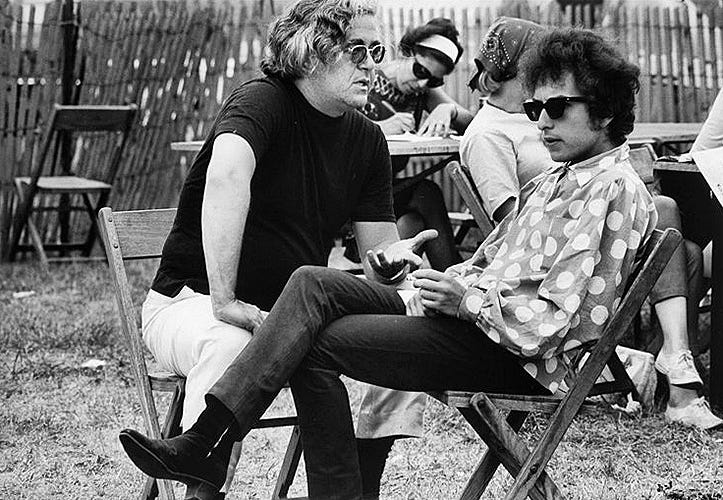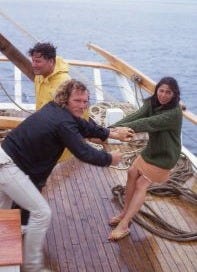
The new film A Complete Unknown has fostered a great deal of conversation. I’ve seen it, and I think it to be excellent. Chalamet as Bob Dylan and Edward Norton as Pete Seeger are especially superb.
Some Dylan purists have quibbled with the film’s occasional condensation of historical events. But this type of thing routinely becomes necessary when a screenwriter and director are working to incorporate several years of activity into the storyline of a film that will run only about two hours.
Here's one example:
It’s not important that Seeger and Dylan didn’t actually meet for the first time in Woody Guthrie’s hospital room shortly after Dylan arrived in New York City. It’s only important that they did indeed meet – regardless of the circumstances – shortly after Dylan arrived in New York City. Putting Dylan, Seeger, and Guthrie in one room at the same time quickly [key word] documents: Dylan meeting Woody, Dylan meeting Seeger, and the fact that Woody is incapacitated in an institution.
The screenplay not only condenses some historical events, but also – once again, of necessity – some characters. The novelist Evelyn Waugh once said words to the effect that it is important, when telling a story, to realize that some characters are there to be fully developed and endowed with personalities, emotions, and motives … while others are simply props: furniture.
Thus, we have a number of prominent historical figures from the early sixties folk music scene who in the film become one dimensional prototypes – with those single dimensions nevertheless being accurate, so far as they go.
Folklorist Alan Lomax, for example, was indeed – as portrayed – a hard-nosed, short-tempered, and abrupt folk music purist who disdained the commercialization of roots music. That is all we ever learn about him. And this is OK because there’s simply no time in which to flesh the man out. Additionally, in the context of the cinematic story being told, there is no need to flesh him out. The Alan Lomax of the film is simply a symbol for Dylan and Seeger to bounce off and react to.
The same goes for the famed agent and manager Albert Grossman, who was indeed – as portrayed – the very embodiment of the type of commercialization that Lomax disdained. (By the way, the two men genuinely did hate each other, as shown in the film.) But once again, that’s all we need to know about Grossman in order to move the story along.
Other tangential figures receive similar superficial treatment, including Toshi Seeger.
I was a close friend of Pete and Toshi Seeger from the early 1970s, when I was about 14, till their deaths in 2014 and 2013, respectively. I practically lived at their home outside Beacon, NY, for a period during my time as a student at a nearby college.

In 1976, my (deservedly brief) career as a folk musician reached its peak when (to my astonishment) Pete and I wound up collaborating (and sharing equal billing) on a duets album for Moe Asch’s Folkways Records (now Smithsonian Folkways) - Fifty Sail on Newburgh Bay: Hudson Valley Songs Old and New. (It wasn’t too long after this that I began my entry-level career in book publishing. The reviewer writing for Sing Out! Magazine had been kind, but a friend wryly commented that my voice and guitar skills were “perfect for publishing.”)
Given my closeness with Pete and Toshi, when watching A Complete Unknown I was particularly attentive to the ways in which each was portrayed. Pete of course is a featured character very central to the story being told. Along with Dylan he is at the hub of the entire enterprise.
Toshi, however, is reduced down to another one-dimensional symbol: an adoring and largely silent wife regularly at Pete’s side, or more frequently behind him, nodding in rhythm with everything he says. Once again, this brevity may well be necessary – but, unlike other simplistic character summations in the film, this one is far from being anywhere near the truth.
Toshi was a brilliant, outspoken force of nature – and by no means a “Stepford wife.” She took no prisoners. She did not suffer fools. And she was anything but a tagalong. Throughout Pete’s career she was with him every step of the way, but not as a mere traditional wifely helpmate.
For decades, Toshi acted as Pete's highly influential and very active co-manager along with the empresario Harold Leventhal. In the final analysis, she was one hell of a business woman, administering all of Pete's complex affairs in close partnership with Harold.
The Newport Folk Festival itself would simply not have existed without her savvy insight, her managerial expertise, and her active participation on the festival board of directors.
She also acted as Pete's shrewd protector, for lack of a better word.
Pete always assumed everyone he encountered was as idealistic as he and as honest as he. Toshi knew better. She had a sharp eye. She could spot an opportunistic charlatan from a mile away. And there were plenty to spot.
Perhaps most importantly, Toshi had a special talent for taking preposterously idealistic dreams - dreams such as Pete was in the habit of originating - and nurturing them into reality.
Consider: Pete might propose building a massive sloop to serve as flagship for the American environmental movement. But then it would be Toshi who’d creatively leverage his celebrity, combining it with aggressive fundraising and astute community organizing, to actually make it happen.
Her résumé does not end there.
Toshi produced and directed Pete’s television program Rainbow Quest, which ran through 1964 and 1965. In 2007 she served as Co-Executive Producer (with none other than Norman Lear) for the Emmy Award winning PBS American Masters documentary Pete Seeger: The Power of Song.
Personally, I considered Toshi to be a second mother. Perhaps that is why I feel protective towards her memory.
The last time I saw her to speak with her, I was in my fifties. I must have been going through some sort of midlife crisis because I'd let my hair grow long. Thus I looked pretty shabby (and, in retrospect, absurd) when on one early Spring morning I went up to the Seeger house with my son Bill and Bill's college roommate to help Toshi and Pete boil down maple sugar.
At the very end of the day, as we were about to leave, Toshi and I gave each other a hug during which she whispered a firm motherly command into my ear: "Cut your hair. You're not 14 anymore."
That was Toshi.
I did as I was told.





This was wonderful. Thanks so much for this post.
I appreciate the way you explain the necessity of eliding time and character. All historians curate the story and the details, and we use the tools available to us in each medium. “Edited for length and clarity,” as the newspapers say these days.